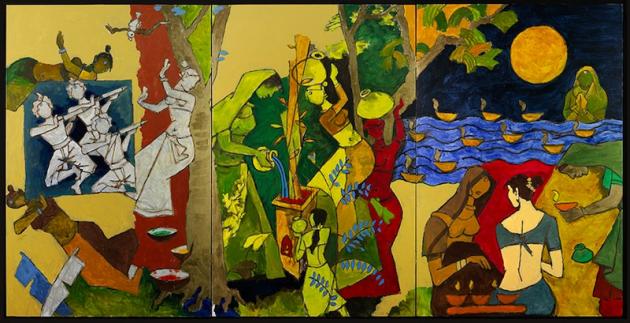An exhibition of the final works by the Indian painter Maqbool Fida Husain, known as M.F. Husain (1915-2011) is to be mounted at London’s V&A Museum. Husain was one of India’s most eminent artists. Born in Pandharpur, his early years were spent in Indore. Husain began his career as a painter of cinema hoardings after attending art school in Bombay (now Mumbai). Using freehand drawing and vibrant colour, he depicted Indian subject matter in the style of contemporary European art movements, particularly Cubism. Indian Civilization is an ambitious series of eight triptych paintings, commissioned in 2008 by Mrs Usha Mittal as a tribute to the richness of India’s history. Each panel explores a different theme, together creating a personal vision of India, what Husain called ‘a museum without walls’.
Interweaving religious and symbolic iconography with historic figures and events, the paintings also incorporate memories from the artist’s own life. Originally envisaged as a series of 96 panels, Husain was still working on the paintings at the time of his death in 2011. Husain marked the ceremonial beginning of his Indian Civilization series by painting the Hindu deity Ganesha. Known as the remover of obstacles, Ganesha is a patron of the arts and letters, worshipped at the beginning of any endeavour. He is represented as a four-armed man with an elephant head, shown here with an ancient terracotta goddess figure at his side.
Husain celebrates three ruling dynasties from India’s long and tumultuous history. He places the ancient Mauryan civilization centrally between two invading rulers, the Muslim Mughal dynasty (1525-1857) and the British Raj (1858-1947). Husain died in June 2011 in hospital in London aged 95 after years of self-imposed exile.

